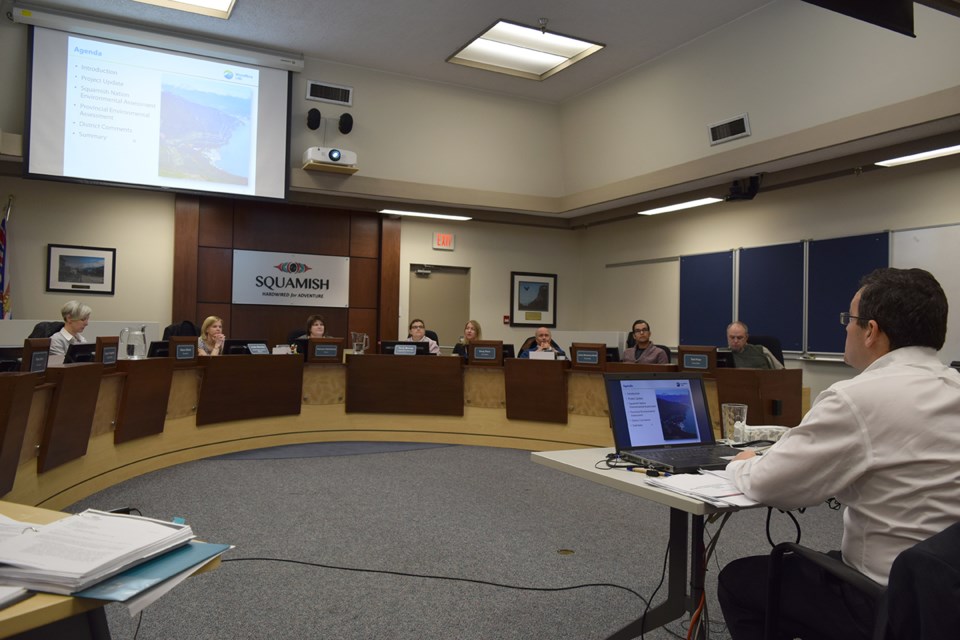The District of Squamish is now moving ahead with discussions with Woodfibre LNG in case the project goes ahead.
With two major conditional approvals behind the liquefied natural gas project, council passed motions Tuesday at its committee of the whole directing district staff to have preliminary planning discussions with Woodfibre LNG representatives on issues of concern to both parties, should the liquefied natural gas export facility be built.
One motion was for staff to work with the proponent to come up with terms of reference for a socio-economic study on the impact the plant and its construction would have on Squamish. The other motion was for district staff to begin preliminary talks with Woodfibre LNG on a number issues such as marine considerations, a property tax agreement and community services that may be impacted.
The socio-economic study terms of reference and an outline of work district staff will need to do for the project will be presented at a future council meeting.
“Generally we are saying we need to create this dialogue, we need to understand the impacts and where those impacts will happen within the process,” said Mayor Patricia Heintzman.
On Oct. 14, the Squamish Nation chiefs and council granted conditional approval of the project, and on Oct. 26, the provincial government issued the project its conditional Environmental Certificate.
Councillor Doug Race said discussions are necessary at this point.
“We want to have this discourse, because we can’t just stick our heads in the sand and pretend this is just not going to happen.”
The motions came after a presentation by Woodfibre LNG’s Byng Giraud, vice-president of corporate affairs, which was followed by a question and answer session in front of a packed chamber Tuesday afternoon. Giraud said he anticipates conditional federal approval will be granted within the next few months.
Councillor Karen Elliott said she was concerned about the amount of time staff would dedicate to the liquefied natural gas project before the final investment decision by Woodfibre LNG.
“I don’t disagree that if the final investment decision is made, then we want a really close relationship and so maybe there are some preliminary conversations that need to happen, but I am just really concerned with an Official Community Plan review and the Oceanfront deal and other major developments in town where exactly our staff have any sort of substantial time,” she said. “So I am just trying to figure out how we resource this.”
Chief administrative officer Linda Glenday agreed staff time is an issue.
“Definitely this is going to take more resourcing than we currently have capacity for,” said Glenday.
Councillor Jason Blackman-Wulff objected to the idea of calculating how much district staff time for Woodfibre LNG would cost.
“Why would we not do something similar, for example, for the Great Wolf Lodge?” he asked. “We haven’t directed staff to scope out what the potential future cost might be of staff time and things like that. I think that is just the way of doing business, you have an application before you, you deal with it…. I am concerned that the costing will then become a political football to throw around for those who may not want to see the project move forward.”
“As far as I’m concerned,” said Councillor Ted Prior, “this is the first meeting we’ve had where it looks like we might be getting an LNG plant... There were still doubts up until a little while ago.”
Giraud answered several questions from council and from a few audience members, including a question from Councillor Peter Kent on the viability of the project, given the falling price of natural gas.
“I would be mistaken if I were to say to you right now that the economics aren’t tough, but we are not pulling away from this project,” said Giraud. “What we are trying to do is manage our costs, so from the purchasing of that gas, the cost of the transportation and pipeline, the cost of liquefaction.”
Giraud said purchasers of liquefied natural gas who want to have a supply over the long term are going to have to pay the costs.
“So what you may see is utilities looking at companies like ours and companies in the northwest saying, ‘If you can help us manage our long-term costs… then perhaps we can provide you a price that will allow you to make this project viable.’”
The company owners are set to make a final investment decision sometime in 2016.




